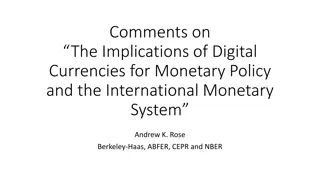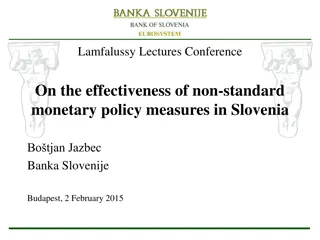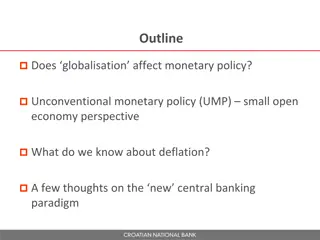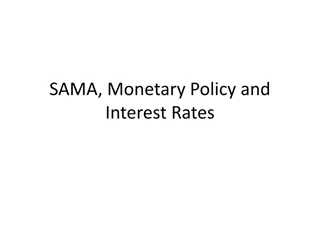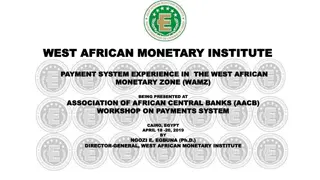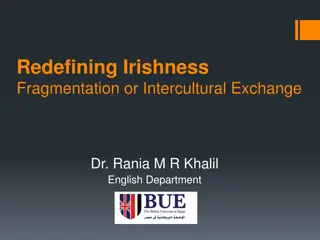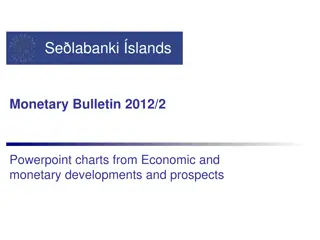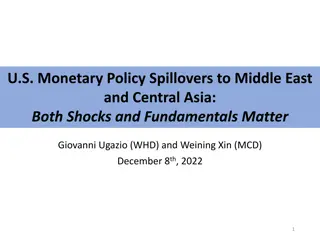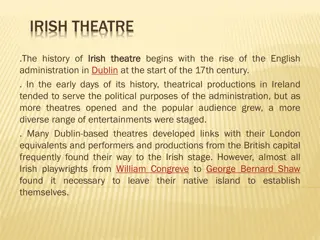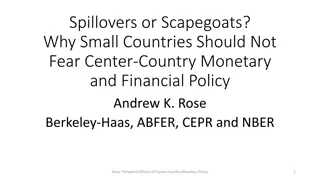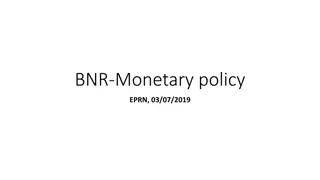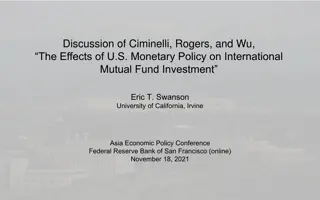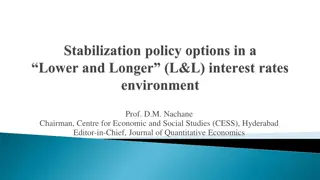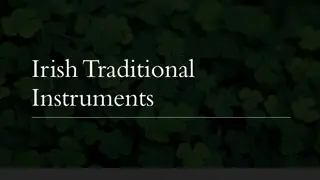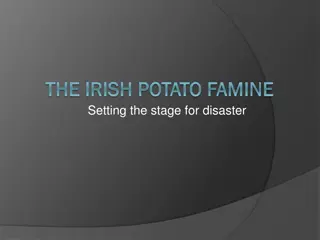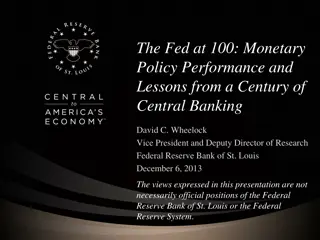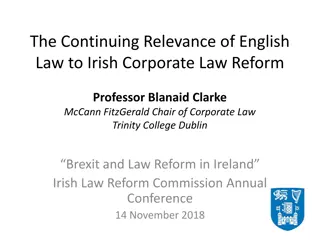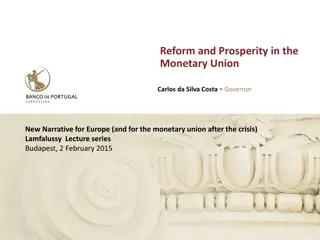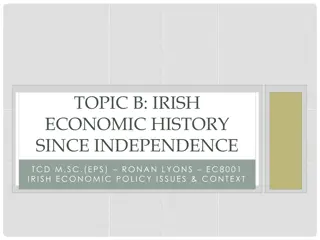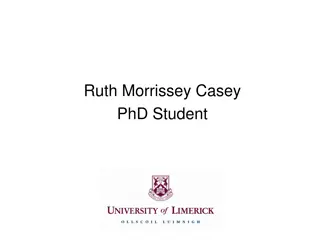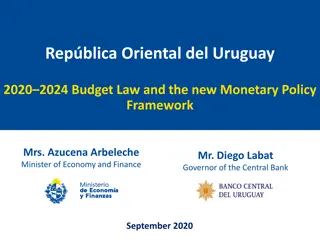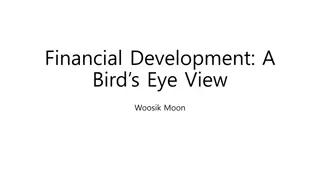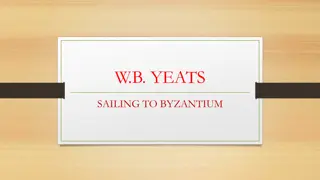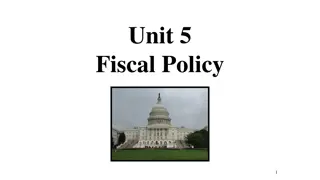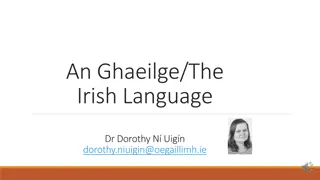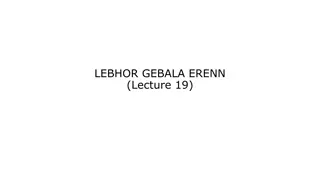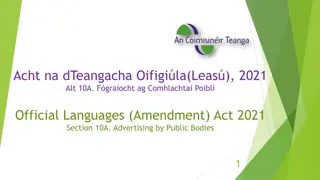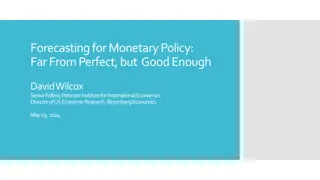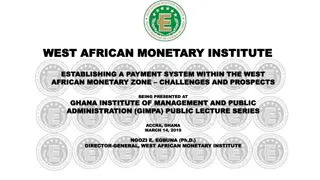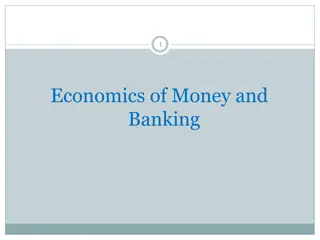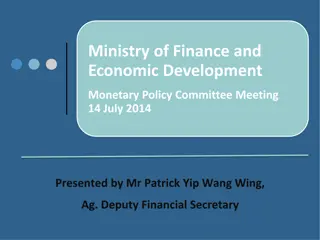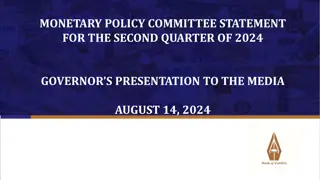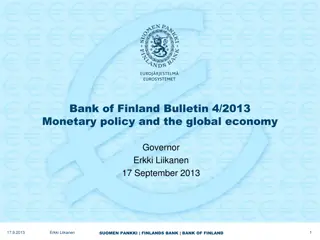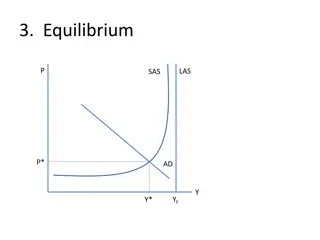Evolution of Irish Monetary Policy 1922-79: Economic Realities and Policy Approach
The Anglo-Irish Monetary Union saw Ireland navigate economic challenges and dependency on the UK from 1922-79. The incremental approach to currency and banking policy, along with the establishment of the Central Bank of Ireland, shaped the country's financial landscape. Key milestones included the Anglo-Irish Treaty, introduction of the Irish pound, and responses to Balance of Payments crises.
- Irish Monetary Policy
- Economic Realities
- Currency and Banking Policy
- Central Bank of Ireland
- Financial History
Download Presentation

Please find below an Image/Link to download the presentation.
The content on the website is provided AS IS for your information and personal use only. It may not be sold, licensed, or shared on other websites without obtaining consent from the author. Download presentation by click this link. If you encounter any issues during the download, it is possible that the publisher has removed the file from their server.
E N D
Presentation Transcript
THE ANGLO-IRISH MONETARY UNION Bulgarian National Bank/European Association for Banking and Financial History 1922-79: Sofia, Bulgaria 1st July 2022 Dr. Eoin Drea Wilfried Martens Centre for European Studies
1. Economic realities and an incremental Irish policy approach FROM CONFRONTATION TO CONCILIATION 2. The continuity of dependency advantages for Ireland FOCUS ON 1922 - 1943 3. Contemporary lessons for Ireland, other small Eurozone economies (and Scotland)
1. ECONOMIC REALITIES - - - - Anglo-Irish Treaty of December 1921 partition civil war Bursting of post-war boom (agriculture over 50% of employment) Full monetary and fiscal autonomy for the Irish Free State (Ireland) Overwhelming trade dependence on the UK (98% of exports in early 1920s, still over 92% in 1938) Well established, stable and profitable commercial banking system centered on the City of London (Dublin, Cork, Belfast, London) all predating 1922 continued operating on an all- Ireland basis Only 3.3% of commercial banks investments held in Ireland in 1926 High level of deposits and external assets Anglo-Irish Financial Agreement of 1925 was the largest debt relief of the 20thcentury (Fitzgerald and Kenny 2020) but high political cost - - - -
1. INCREMENTAL CURRENCY AND BANKING POLICY 1922-27: exceptionally confused British coin, British Treasury notes, Bank of England notes and Irish Bank notes circulated freely. However, neither the Bank of England or Irish bank notes were recognised as legal tender, while Treasury notes issued before 1921, although legal tender, bore no date of issue and could not be recognised (Meenan 1970) 1927-43: Irish Currency Commission (operated as a Currency Board) - Introduction of Irish currency notes (Irish pound) - Irish pound fixed at one for one parity with sterling (fully covered) - Following Bank of England interest rate policy - Commercial Banking reserves remained in London - Influenced by the Federal Reserve Act 1913 (Drea 2015) - In line with wider trends in the decolonising British Empire, but perhaps more conservative than the other self governing dominions
1943-79: Central Bank of Ireland (CBI) - Remained highly conservative - Currency issue remained fully backed (only by gold and sterling) - With is large net holdings of external assets, (the Irish commercial banks) had no need of the new Central Bank as a lender of last resort (Honohan 1994) 1. INCREMENTAL CURRENCY AND BANKING - Acted as de facto Currency Board up to the late 1960s/early 1970s - From mid-1960s modest lending to banks/allowance of US Dollar reserves/imposition of reserve requirements on banks/enforcement of credit policy POLICY - Mid 1950s Balance of Payments crisis provided a stark reminder of Ireland s economic dependencies CBI declined to rise interest rate in line with BOE Devastating Balance of Payments crisis (Honohan and O Grada1998) Surge in emigration and draconian fiscal response required to rectify the trade balance
Irish Civil War Anglo-Irish financial agreement Going off gold economic crisis coming to power of Fianna Fail (more Republican and perceived as economically radical) dilution of role of British monarch in Irish affairs Anglo Irish Trade War Irish refusal to enter British war effort (remained neutral) low point of Anglo-Irish political relations Declaration of Republic of Ireland (leaving the Commonwealth) 1932 1938 1922 1923 1925 1931 1932 1930s 1939 1940s 1949 1. CURRENCY AND BANKING CONTINUITY WAS REMARKABLY RESILIENT DRIVEN BY ECONOMIC DEPENDENCIES AND ULTIMATELY POLITICAL REALISM
2. ADVANTAGES OF A CONTINUITY DEPENDENCY Conservative Irish approach viewed negatively a bleak prescription (Fanning 1978) an attachment to power and prestige (Maguire 2008) But a more balanced view of Ireland s sterling approach is required: 1. Helped avoid the monetary instability of the 1920s evident in many of the other successor states in Europe Austria, Hungary, Poland (Drea and Barry 2021) 2. Maintained banking stability in a Europe beset by banking failures during the inter-war period Spain, Portugal, Italy, Germany (Feinstein et. al. 1995) 3. Banking and currency stability facilitated a more expansive fiscal policy in the 1930s while maintaining Ireland s reserves in London (notwithstanding the Anglo-Irish trade war)
2. ADVANTAGES OF A CONTINUITY DEPENDENCY 4. Inflation and interest rates paralleled those in Britain (only became a problem from the 1950s on due to Britain s own domestic economic issues) 5. Reflected prevailing economic thought in the 1922-43 period: moving from free trade (1920s) to protectionism (early 1930s) even Keynes understood the constraints: For countries which are small compared with their neighbours, or do not contain independent financial centres of international importance, an Exchange Standard may be ideal. But it does undoubtedly involve some measure of dependence on the country whose money is chosen as the basis of the Exchange Standard, which may be hurtful to the national pride (Keynes 1930). Such hurt resulted in continuous political pressures (Brownlow 2010)
1. Banking and trade links can endure through very significant political confrontations 3. We export more to Ireland than to Brazil, Russia, India and China put together . more Irish companies are listed on London exchanges than companies from any other foreign country. The two main Irish- owned banks have an important presence in the UK, holding between them about 30 billion of customer deposits. In Northern Ireland, two of the four largest high street banks are Irish-owned, accounting for almost a quarter of personal accounts George Osborne MP (Chancellor of the Exchequer, 2010) CONTEMPORARY LESSONS IRELAND AND THE EUROZONE 2. The absence of operational monetary autonomy for Ireland with a fixed sterling peg and now under the Eurozone makes fiscal policy even more important to maintaining economic balance (Ireland from mid-1990s to 2007)
3. There is a potential trade-off between currency stability and domestic development 3. The use by the (Irish) banks of the London money market for their liquidity needs, were not conducive to the development of risk management and trading skills in Ireland (Honohan 1994) CONTEMPORARY LESSONS 4. As alluded to by Keynes in 1930 for smaller states in de facto monetary unions the prevailing performance of the larger trading/currency partner is critical A. Ireland from the 1950s (and also today an outlier in the Eurozone flexibility lost ) IRELAND AND THE EUROZONE B. Many smaller Eurozone members (particularly in Central and Eastern Europe (e.g. Slovakia) C. Relevance also for Croatia/Bulgaria (important to move towards a more complete EMU, but unlikely in the medium term)
3. 5. Currency and Banking uncertainty is one of the key arguments of those advocating against possible Scottish independence CONTEMPORARY LESSONS The Irish example of 1922-79 is both useful and relevant While an independent Scotland may wish to set up an independent central bank, the experience of Ireland suggests that adopting a de facto central bank with a flexible currency board style arrangement may be a suitable approach such an approach shields policy- makers from certain political pressures, while offering the credibility and policy space to alter the regime (Kenny and McLaughlin 2022) SCOTLAND Dependent on accommodative relationship with Bank of England
Thank you! 3. CONTEMPORARY LESSONS ed@martenscentre.eu IRED



